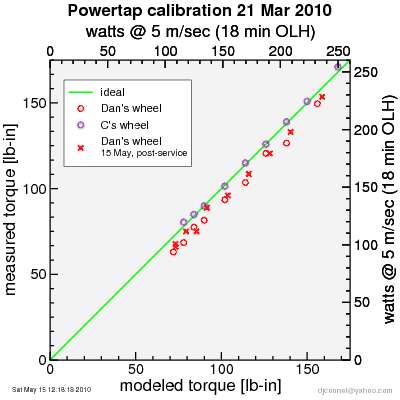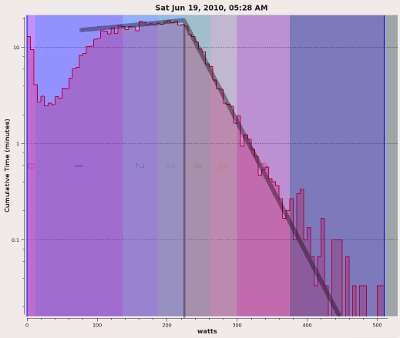2010 Terrible Two: power data
 I don't use my PowerTap on hillclimbs because it's too heavy, and I don't use my PowerTap in mass-start races because sometimes you've just got to dig deeper than you think you can. But for Terrible Two, I decided within the last few days I wanted it. Sure, hauling that 1020 gram wheel up 16 thousand feet of climbing was going to add work, and work equals time. But a double century for me isn't about minimizing work, but rather in minimizing work done over threshold. And to keep my enthusiasm in check on the early climbs the power numbers would be useful. Additionally, as a diagnostic tool it would be really valuable. I wanted to compare the power I could sustain on later climbs to those I was able to hold on the earlier climbs.
I don't use my PowerTap on hillclimbs because it's too heavy, and I don't use my PowerTap in mass-start races because sometimes you've just got to dig deeper than you think you can. But for Terrible Two, I decided within the last few days I wanted it. Sure, hauling that 1020 gram wheel up 16 thousand feet of climbing was going to add work, and work equals time. But a double century for me isn't about minimizing work, but rather in minimizing work done over threshold. And to keep my enthusiasm in check on the early climbs the power numbers would be useful. Additionally, as a diagnostic tool it would be really valuable. I wanted to compare the power I could sustain on later climbs to those I was able to hold on the earlier climbs.Now, I've already documented here my torque measurements suggest my Powertap reads low. The steeper the climb, the more low it reads. This error is on the order of 10 watts or so, so view numbers reported here with that sort of error bar.
 My PowerTap reads around 10 W low at Old La Honda climbing speeds.
My PowerTap reads around 10 W low at Old La Honda climbing speeds.Anyway, I'm glad I used it. At least I think I am. On the Bennett Valley climb I let the Webcor-led lead group go, as they would have pushed me well into the red zone. And while staying out of the red zone cost me contact with the leaders, I still found myself with very useful pacelines on the segments through lunch which are most critical on the ride for pacelining, and I was able to climb strongly on every single climb during the day. Could I have stayed with the lead group? I'll never know. But I consider it far more likely I would have run myself into the ground trying. I'm happy with how things went.
Whoops, jumping ahead.... here's the power data, which shows what I just described. Climbing in the low-200 W range @ my 56 kg mass isn't going to impress anyone at Low-Key Hillclimbs, but for efforts sustained over 3 vertical miles of climbing over 13 hours of riding, it's fairly solid.
 Power data w/ 90 second smoothing
Power data w/ 90 second smoothingYou can see a relatively broad peak at around 630 minutes followed soon after by a narrower peak. These are the Fort Ross climbs. On the second peak, I was clearly starting to fade a bit, but not too badly. It was on the descent I really lost it. I'd really emptied my tank on that climb, and with the pounding of the poor pavement on the descent, I was slipping into survival mode, barely able to crack 100 watts.
But then you can see a notch corresponding to the Rancho Rio rest stop. There, I had between 1/3 and 1/2 of a Coca Cola can. Leaving the stop, I was able to grab Bryan Kilgore's wheel (I am guessing it was Bryan's) as he passed, having not had the confidence to follow Ryan Spaulding when he'd passed not long before. Bryan kick-started my legs, and my power came up: a broad plateau sharing pulls with him on the flats, then a taller peak climbing the Bohemian Highway to Occidental. After that the descent, a notch where I caught Ryan at a red light where we both waited further, then the final "sprint" into the finish.
Another plot I like is the power histogram which shows how much time is spent near each power value. Here's my result from the Terrible Two, omitting zero power. Note the power axis is logarithmic, and power numbers are from unsmoothed 2-second samples.
 Power histogram
Power histogramYou can see two clear segments annotated with line segments. The first is a relatively broad distribution corresponding to the power zone in which I spent a lot of time. After this, there is a zone of remarkably consistent exponential decay. I put a vertical line where these zones intersect. Coggan and Allen point out this sort of plot is useful for extracting a functional threshold from race data, where the body naturally avoids riding above threshold, yielding an exponential decay of duration with increased power above this power level. So from this I might conclude my threshold (at least as reported by my PowerTap) is 222 watts, right? Well, no. The issue here is I was riding to my power meter, intentionally avoiding powers higher than this. I wasn't relying on my body to refuse to ride at higher powers, it was part of an intentional plan. So in this case the 222 watts is a lower bound. Based on some limited climbing data, my present threshold estimate is 260 watts.
Anyway, that's that. Overall it was mostly a successful exercise in pacing. If I ride the Mt Tam Double Century on Aug 7, I'll repeat the process I followed at Terrible Two. Except this time I'll go to the Coca Cola slightly earlier.

Comments